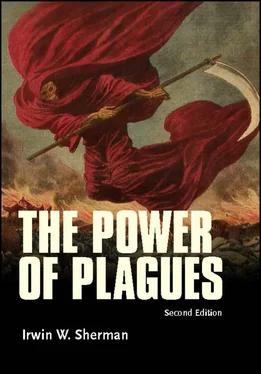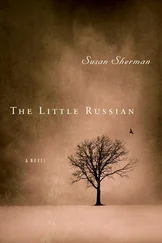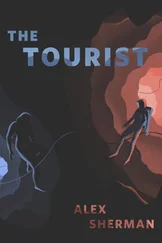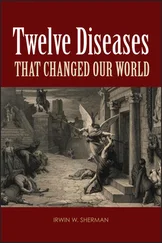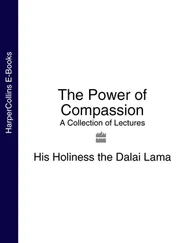The Road to Plagues: More Humans, More Disease
Today we speak of the problems associated with the population bomb—the unbridled growth of humans—that threatens our very existence. This growth in human populations cannot be calculated with any certainty until the middle of the 18th century, but we can make some educated guesses. Three hundred thousand years ago there were 1 million; 25,000 years ago that number had grown to 3 million; and 10,000 years ago the estimated human population was 5 million. By A.D. 1 it was 300 million. The phenomenal growth spurt in the human population coincides with the initiation of agriculture and the domestication of animals, which is generally dated to 8000 B.C. Between 8000 B.C. and A.D. 750, the population of the world increased 160 times to 800 million. Not only was the human population increasing, so too was overcrowding. For example, in 8000 B.C. human density was 0.2 people per square mile, but by 4000 B.C. it was 4 people per square mile.
What is the basis for this growth in the human population? The English clergyman Thomas Malthus (1766-1834) wrote An Essay on the Principle of Population in 1798, in which he stated that a population that is unchecked increases in geometric fashion. Malthus assumed that there would be a uniform rate of doubling, and this is of course naive, because it leads to impossibly large numbers. (By way of example, if you doubled a penny every day over a month, the final amount would be >$20 million.) It has been said that explosions are not made by force alone, but by a force that exceeds restraint. As Malthus correctly observed, there are factors that will eventually bring population growth to a halt; for example, restraint could result from the fact that the food supply increases only arithmetically. The consequences of unrestrained population growth, in Malthus’s words, would lead to “misery and vice,” or, in today’s vernacular, to starvation, disease, and war. These would tend to act as “natural restraints” on population growth. Thus, the Malthusian model suggested that a natural population has an optimal density.
If we were to make a graph plotting the human population on an arithmetic scale from 500,000 years ago to the present, we would find that the resulting curve suggests that the population remained close to the baseline from the remote past to about 500 years ago, and then it surged abruptly as a result of the scientific-industrial revolution ( Fig. 2.5). More instructive, however, would be to plot the same data for a longer time period using a logarithmic scale, since this allows for more of the data points to be placed in a smaller space. This log-log plot reveals that the human population has moved upward in a stepwise fashion, and that there were three surges: those reflecting the development of tool making or the cultural revolution, followed by the agricultural, and finally by the scientific-industrial revolution. What were the checks on human growth rates that limited population size so that at equilibrium (the flat part of the logarithmic “curve”) there was a zero rate of change and the number of deaths equaled the number of births? Two kinds of checks occurred to set the upper limit (or the set point) for population growth: external or environmental factors (including limited food, space, or other resources) and self-regulating factors (such as fewer births, deliberate killing of offspring, or an increased death rate due to accidents or more-virulent parasites). For Malthus, disease and warfare as well as “moral restraint” (birth control) acted as “natural restraints”—the Four Horsemen of the Apocalypse: Disease, Famine, War, and the Pale Rider, Death. Indeed, it has been estimated that prior to the introduction of agriculture the earth could have supported a population of between 5 million and 10 million people who were engaged in hunting and gathering. Agriculture changed the environmental restraint so that the set point, or upper limit, of population size was increased.

Figure 2.5A. Growth of the human population for the last 500,000 years. If the Old Stone Age (Paleolithic) were in scale it would reach 18 feet to the left. B. Log-log plot of the human population over the last million years.
The Effect of Agriculture
Human history took off 50,000 years ago in what Jared Diamond, professor of geography and physiology at the University of California at Los Angeles School of Medicine, called “the Great Leap Forward.” Fifty thousand years ago H. sapiens used standardized stone tools that could be used for cutting, scraping, and grinding, as well as pieces of bone that could be fashioned into fishhooks and spears, needles, awls, harpoons, and eventually bows and arrows. These tools could also be used as weapons, and now humans could begin to hunt down and kill their animal prey at a distance. Not only did these early humans use the meat of animals for their nourishment, but they began to clothe themselves in the skins of these animals. Through the invention of rope it was possible to make snares and nets so that birds and fishes could also become part of the diet. All this attests to the fact that between 100,000 and 50,000 years ago there was a significant change in the cognitive capacity of the human brain without a significant change in its size. Coupled with this change in brain organization was the anatomical improvement of the voice box; now humans could not only speak but also begin to develop language.
For 99% of human existence we were hunter-gatherers, so why some 10,000 years ago did we settle down to become farmers? This change from hunting and gathering to farming has been termed the agricultural revolution, the time when humans domesticated plants and animals and exerted control over food production. Although the term “revolution” would seem to indicate that it appeared suddenly and dramatically, this was certainly not the case. The human control of food production was not discovered or invented, nor was it a conscious choice made by our ancestors “to farm” or “not to farm,” since at the time there would have been no farmers to serve as role models. No, domestication of plants and animals evolved as a consequence of human choice made without any awareness of its future long-term consequences.
Development of techniques and practices for agriculture and animal husbandry progressed step by step in sequential fashion. They were not developed over a short time, and not all the wild animals and wild plants that would eventually be domesticated in a particular region would be domesticated at the same time. Indeed, it probably took thousands of years to shift the human diet from wild foods alone to foods both cultivated and wild. The reason for this time lag is that food production evolved as a result of the accumulation of many separate choices, and there were trade-offs, especially in the allocation of time and effort.
Consider for the moment that you are a hunter-gatherer who has accumulated enough wisdom and technology to set up a small garden. Some of the choices you would be faced with are: Which plants should I grow? How much time should I spend planting instead of hunting or scavenging? What are the benefits of tending the garden over going out to hunt and gather wild plants? Perhaps your most important consideration might be which of the two, hunting or gardening, will save you from starvation in the future. It has been speculated by Jared Diamond that “all other things being equal, people seek to maximize their return of calories, protein or other specific food categories by foraging in a way that yields the most return with the greatest certainty in the least time for the least effort. Simultaneously they seek to minimize the risk of starving. … One suggested function of the first gardeners 11,000 years ago was to provide a reliable reserve larder as insurance in case wild food supplies failed.” Although the factors that contributed to the shift from hunting and gathering to farming still remain controversial with regard to their relative importance, one thing is certain: once there was a shift from nomadic hunting and gathering to more-sedentary food production, there could be no turning back.
Читать дальше
